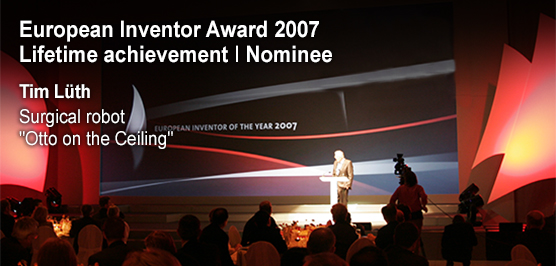Tim Lüth
Surgical robot "Otto the Ceiling"
Superhuman Precision
Precision is everything in fine-tuned medical procedures such as facial or dental implantation surgery. After all, every millimetre counts when surgeons reconstruct a patient's face with silicone implants at levels of detail that exceed what the naked eye can see.
This level of accuracy has improved by leaps and bounds over the past decade thanks to surgical robots that can align the digital model of an implant with the actual anatomy of a patient's body ¬- and tell the surgeon how to proceed accordingly.
Some major achievements in the field of surgical robotics have been made by Professor Tim Lüth of Humboldt University in Berlin, Germany. His inventions have found their way into operating rooms around the world.
Professor Lüth's best-known patented invention to date is a surgical robot nicknamed "Otto on the Ceiling," primarily used in maxillofacial, dental and neurological surgery. A ceiling-mounted device that looks like a gigantic metallic spider, Otto combines a three-dimensional computer positioning system with a precise surgical drill.
This system can obtain live images during the operation, which it then compares to pre-programmed patient and implant coordinates stored in its computer - thereby allowing for constant surveillance of the success of procedures.
But throughout the operation, full control of procedures is with the surgeon. The robot serves as an intelligent tool - a robotic advisor, so to say - which carries the drilling machine on its ceiling-mounted base. The surgeon can use the data from the computer for choosing the right pathway at maximum precision, all the while handling the drilling machine as usual during the whole intervention.
Some company for Otto
Another one of Lüth's inventions is currently finding its way into dental practices. The "RoboDent" consists of a regular PC monitor, a small infrared navigation device - which can be mounted easily on any common dentist's hand piece - and some further additional components.
Just like his robot colleague Otto, the RoboDent aligns pre-planned surgery data with actual positioning feedback of the body for fitting implants in place. As a result, a patient can use his newly inserted dentures at full capacity only a week after surgery. Several hundred RoboDents are already in use across the world.
The main advantage of Professor Lüth's systems is that they leave full control of the operating tools with the surgeon, all the while evaluating "live" data from the patient's body in comparison to pre-planned outlines of the procedures.
A supplement but not a replacement
Viewed in perspective, Professor Lüth's ascent to the medical profession is just as remarkable as his inventions. Not a surgeon by trade, the 41-year-old comes from a background in electro-technology, mixing computer science and engineering.
When Berlin's Charité clinic designated him a doctor, it marked the first time ever in the history of German medical technology that an engineering discipline was institutionally integrated into the field of surgery. His rise would continue: In 1997, Lüth became Germany's first professor of medical robotics at Berlin's Humboldt University. At the time this was a relatively new field with only three chairs worldwide.
Over the past decade alone, Professor Lüth has single-handedly pioneered the development of surgical robots and navigating systems for facial and dental operations. He has contributed to 17 patents and also serves as a counsellor for the medical robotics industry.
But with all the precision offered by robots, will we still need humans in the operating room? According to Professor Lüth himself, his innovations do not aspire to replace the human element in the operation room:
"The surgeon will always remain irreplaceable. Even in the future, robots will not conduct operations independently, but will only assist the surgeon."
How it works
One of Professor Lüth's milestone inventions is a positioning system that aligns computer data with the actual location of the patients' body, making surgical robotics and remotely controlled surgery possible.
During surgery, the robot - widely known as "Otto on the Ceiling" - draws on biometrical coordinates to guide the surgeon's drill with a precision of 0.2 millimetres on target. As a key element, facial prosthetic surgery involves the drilling of holes into the patient's bone tissue. The holes serve to anchor miniscule titanium bolts for holding the implant in place. This could be, for example, a life-like prosthetic ear made from silicone. And it is exactly here that Professor Lüth's robots make a striking difference.
Before the introduction of the robot into clinical practice, facial implant surgery, consisted of two steps: The surgeon would first drill the holes and attach the titanium bolts, and then measure the position for modelling a prosthesis that would fit. This also meant several weeks would pass until the wounds from drilling were healed and the implant could be applied in a second surgery.
But thanks to the robot-guided system, the implant can be modelled in the computer before surgery, using image data of the patient's body. This pre-operative planning stage also evaluates the optimal location for the titanium pins on which the implant will be secured.
From a design perspective, Professor Lüth's invention provides a sound solution to real-life requirements in the operating room. By mounting the device on the ceiling, the concept accounts for the limited space in the operating room. And by leaving the area around the operating table free of obstacles, it allows unprecedented access to the patient, making it the world's first and most frequently used ceiling-mounted medical robot for hospital use.
Contact
European Inventor Award and Young Inventors Prize queries:
european-inventor@epo.org Subscribe to the European Inventor Award newsletterMedia-related queries:
Contact our Press team#InventorAward #YoungInventors



